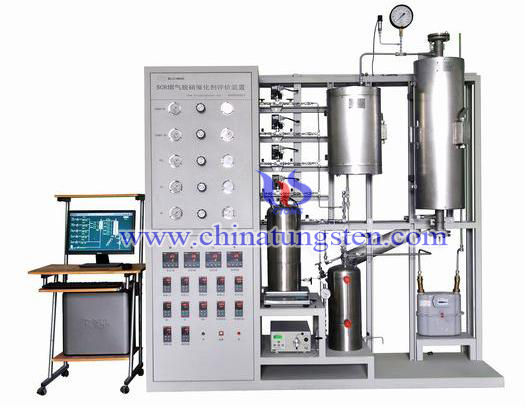Low-NOx Combustion Unit Uses Tungsten Trioxide SCR Denitration Catalyst
- Details
- Category: Tungsten Information
- Published on Wednesday, 13 April 2016 18:24
The two major mechanisms of NOx formation in low-NOx combustion unit are while reducing combustion temperature, the concentration of oxygen in the fire zone also be reduced, in order to suppress the formation of nitrogen oxides in the furnace. The concentration of NOx emissions can be reduced by 30% to 60% by using low-NOx combustion furnace technology. Nowadays, the widely used low-NOx combustion technology is mainly through low-nitrogen furnace transformation, for achieving the goals of low-oxygen, hierarchical partitioning combustion in the furnace, thus to achieve the reduction of NOx emission.

Due to the limitations of the furnace low NOx combustion technology, the NOx emissions can’t meet environmental requirements, so denitration process should be carried out in order to further reduce NOx emissions. Dry, semi-dry and wet method ate the prevailing flue gas denitration processes. Wherein, dry SCR denitration process is of high commercial value and being widely used with its nice properties, such as simple structure, easy operation, high reliability, high denitration efficiency, relatively low initial Investment.
SCR device consists of denitration reaction preparation system and the composition of the reactor body, reducing NOx into nitrogen and water vapor by injecting into denitration reaction agents--NH3 into the reactor. SCR denitration catalysts are generally taking titanium dioxide as a carrier, vanadium pentoxide and tungsten trioxide as the main active ingredients, its activation temperature is generally between 300~400 ℃. Tungsten trioxide plays the role of anti-curing, anti-poisoning in the catalyst, thus to enhance the activity of the catalyst. SCR denitration reactor can be divided into high and low dust categories according to installation location of precipitator. However, due to low dust device needs to install a steam heater and flue gas heat exchanger (GGH), which makes the system complex, investment increased, so the generally chosen is the high dust process.
| Tungsten Oxide Supplier: Chinatungsten Online www.tungsten-oxide.com | Tel.: 86 592 5129696; Fax: 86 592 5129797;Email:sales@chinatungsten.com |
| Tungsten News & Prices, 3G Version: http://3g.chinatungsten.com | Molybdenum News & Molybdenum Price: http://news.molybdenum.com.cn |